Homemade Blueberry Jam
This delicious homemade blueberry jam is made with fresh blueberries, lemon juice, sugar, and pectin for a not-too-sweet summer treat you will want to slather on everything! Learn how to make and can blueberry jam with this easy-to-follow step-by-step guide.
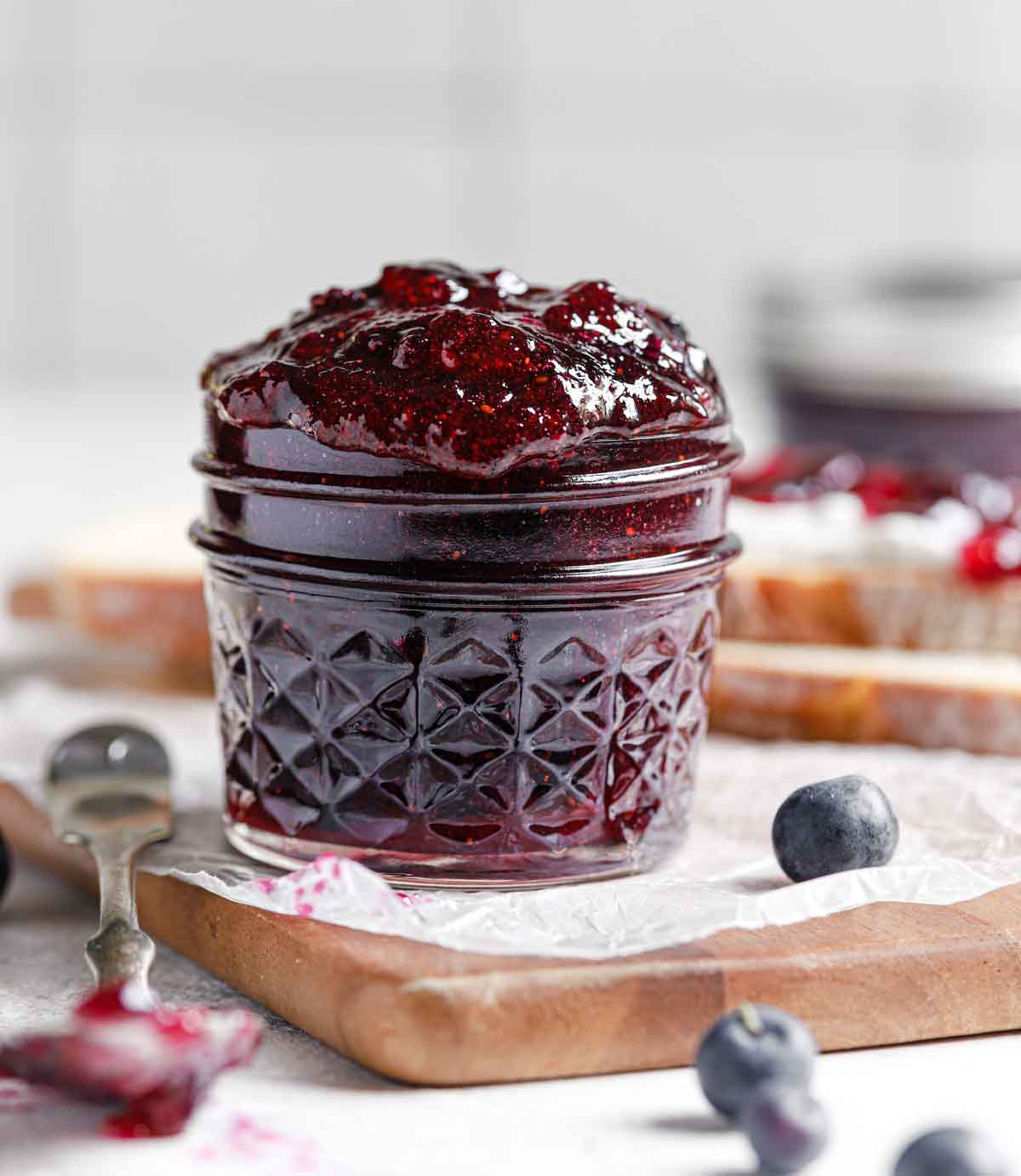
In all of the cooking, baking, and creating I have done since starting this website in 2007, I can honestly say that these jars of blueberry jam have given me the greatest sense of kitchen satisfaction since I mastered yeast bread.
Delicious Homemade Jam
Sometimes I rush around the kitchen with my mind in a million different places at once. When I make this jam, I slow down. It doesn’t happen consciously, but I eventually become aware that I’ve allowed myself to become fully immersed in the process.
Crushing fresh blueberries, stirring the jam while it boils, carefully filling each hot jar with the mixture, and picking them up, one by one, once they’re finished. I enjoy every step and can see how folks get into a serious canning habit. It’s more than just filling jars with jelly or jam; it’s a reminder that even though we’re busy, every once and a while, we can allow life to slow down, be simpler, and be in the moment.
Ingredients You’ll Need
This blueberry jam comes together with just a few simple ingredients to make a preserve perfect for slathering on toast and biscuits. Whole or crushed blueberries cook with sugar and lemon juice until they reach a gelling point, then pectin is used to help obtain a thicker jam.
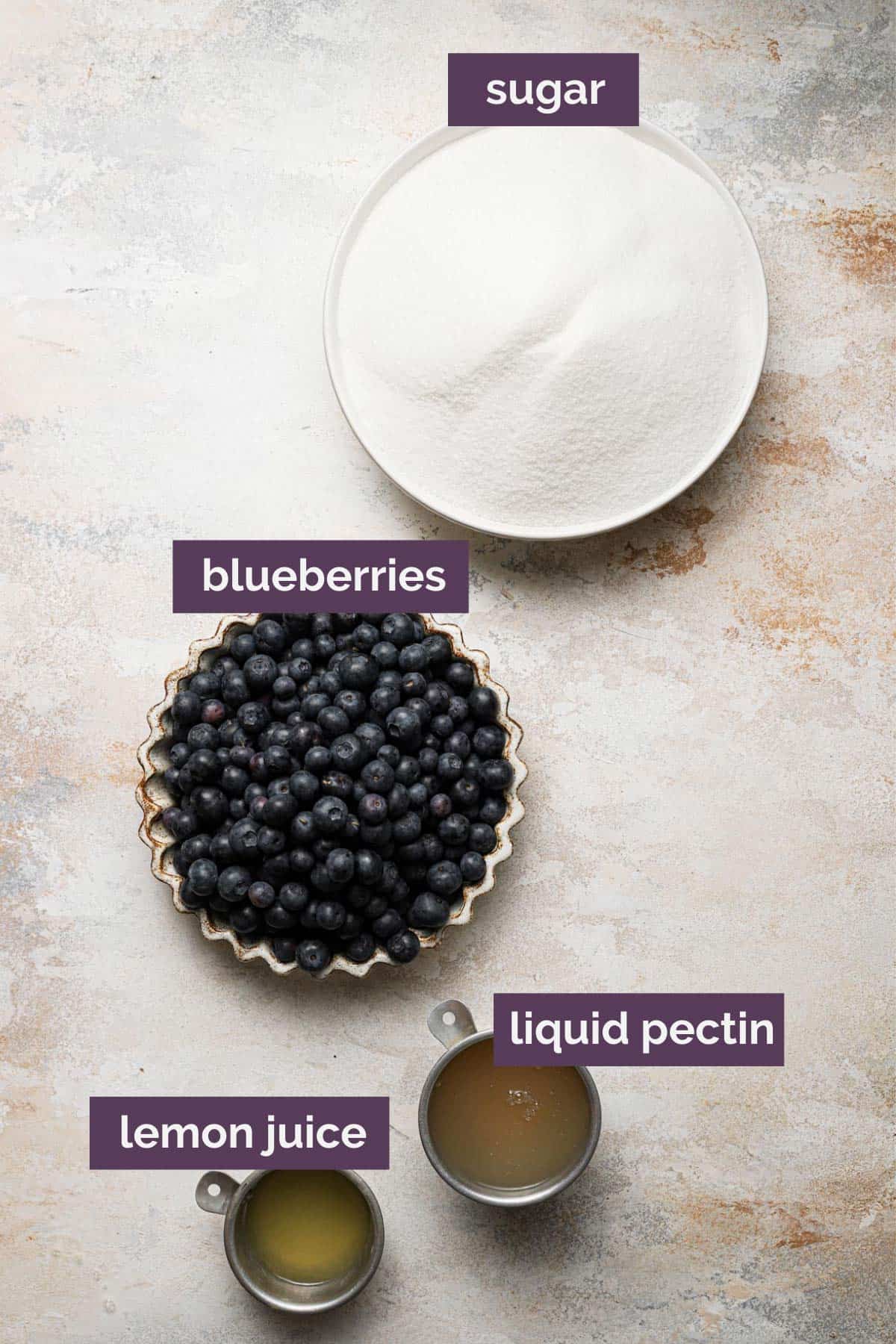
- Blueberries: Fresh or frozen blueberries work well in this recipe. I prefer fresh blueberries over frozen ones when they are in season.
- Lemon Juice: Used to lower the pH in the blueberry mixture so the pectin can set properly.
- Sugar: Sweetens the jam without making it overly sweet.
- Liquid Pectin: Helps thicken the jam without using too much sugar. Most grocery stores carry it, or you can purchase it online.
Sweeteners and Substitutions
I use granulated sugar to sweeten the blueberry jam in this recipe, but if you are looking for a substitute, here are a couple of options to try:
- Honey: Replace the granulated sugar with half the amount of honey. So instead of 7 cups of sugar, you will use 3½ cups of honey.
- Stevia: For making a “sugar-free” jam, use one teaspoon of stevia for every cup of sugar the recipe calls for and adjust based on taste.
- Other Fruit: You can substitute any other berries in this recipe (blackberries, raspberries, strawberries, even huckleberries)! Just be sure to use the same amount and crush them coarsely first.
Jam vs. Jelly
Jam differs from jelly in one main way. For jelly, the fruit is often crushed and cooked, then strained for its juices. This results in a clear consistency versus the chunky consistency of a homemade jam.
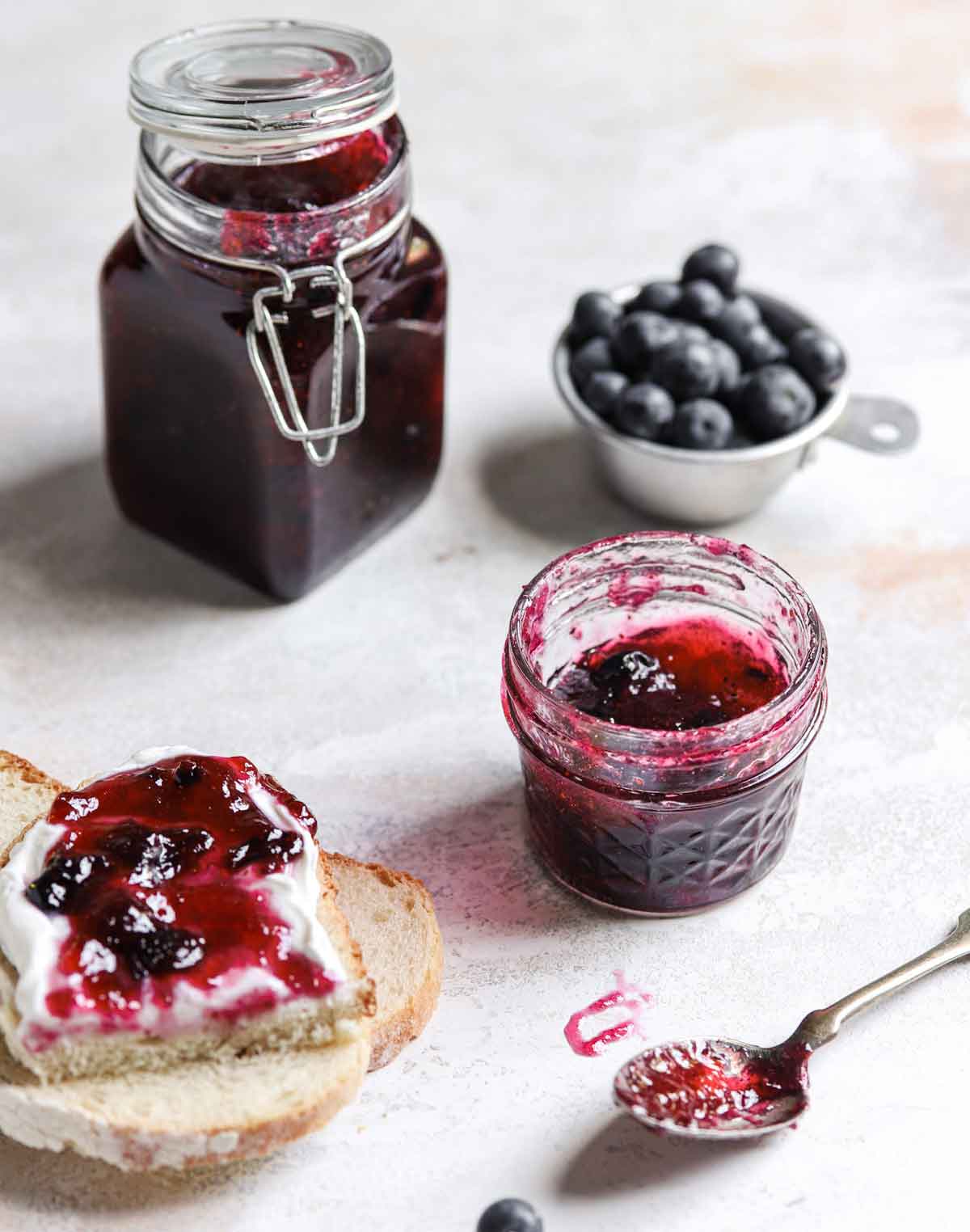
Canning Equipment
When I first considered canning, I was intimidated by the process and the extra equipment I thought I needed. In the end, I was thrilled about how wrong I was regarding the entire process and what was necessary to get started.
This is all you need:
They also sell entire canning starter kits that include the large canning pot and all the accessories you need.
How to Make Homemade Blueberry Jam
- Prepare the Canner, Jars, and Lids: You will wash all of the equipment in hot, soapy water and then place the jars in the water bath canner and lids in a saucepan to simmer and keep warm while you prepare the jam.
- Prepare the Jam: Crush or mash your blueberries using a fork or potato masher, then combine them in a saucepan with the lemon juice and sugar. Bring it to a boil, then add the pectin and boil for a minute longer.
- Can the Blueberry Jam: Fill the jars with jam, add the lids and screw bands, then place the jars in the canner.
- Seal the Jars: Fill the canner with water to cover the jars, then bring to a full rolling boil and continue boiling for 10 minutes. After they sit for 5 minutes, remove the jars and allow them to sit in a draft-free place for 24 hours.
- Check the Jars: When processed jars have cooled for 24 hours, check the lids for a secure seal. To do this, press down on the center of each lid. Sealed lids will be concave (they’ll curve downward) and will show no movement when pressed.
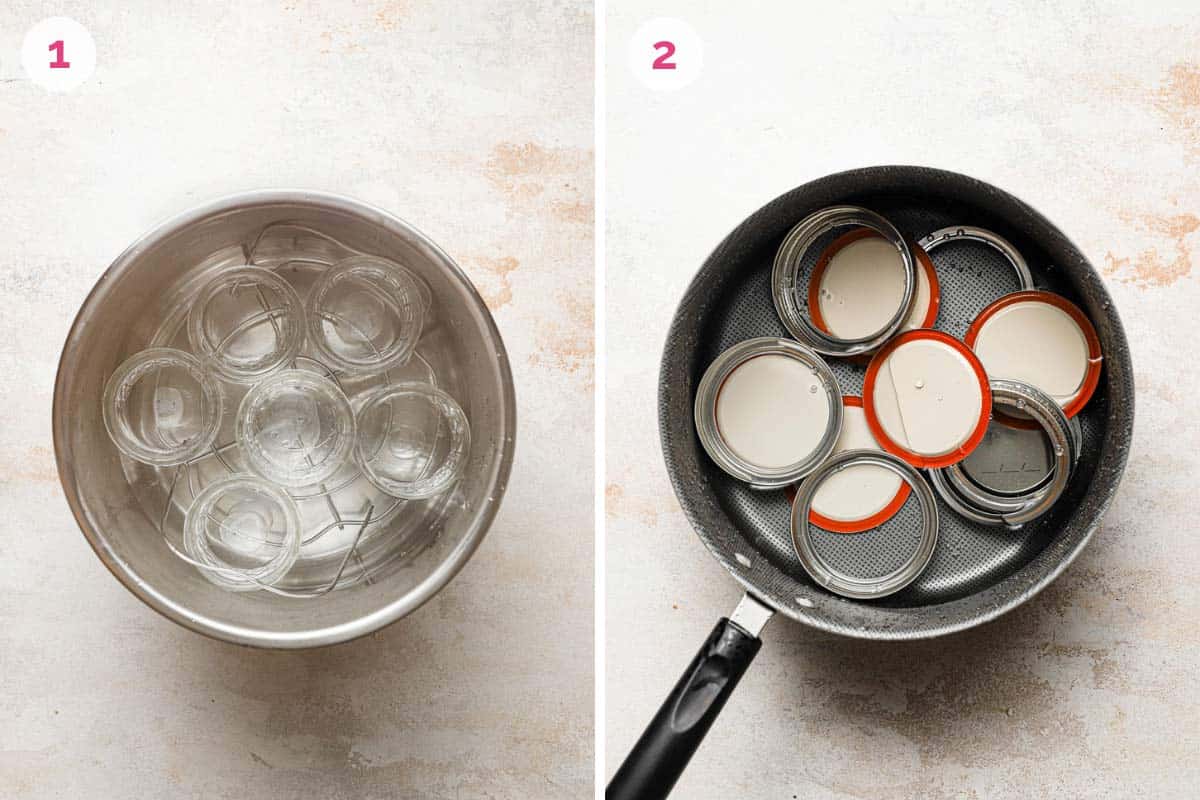
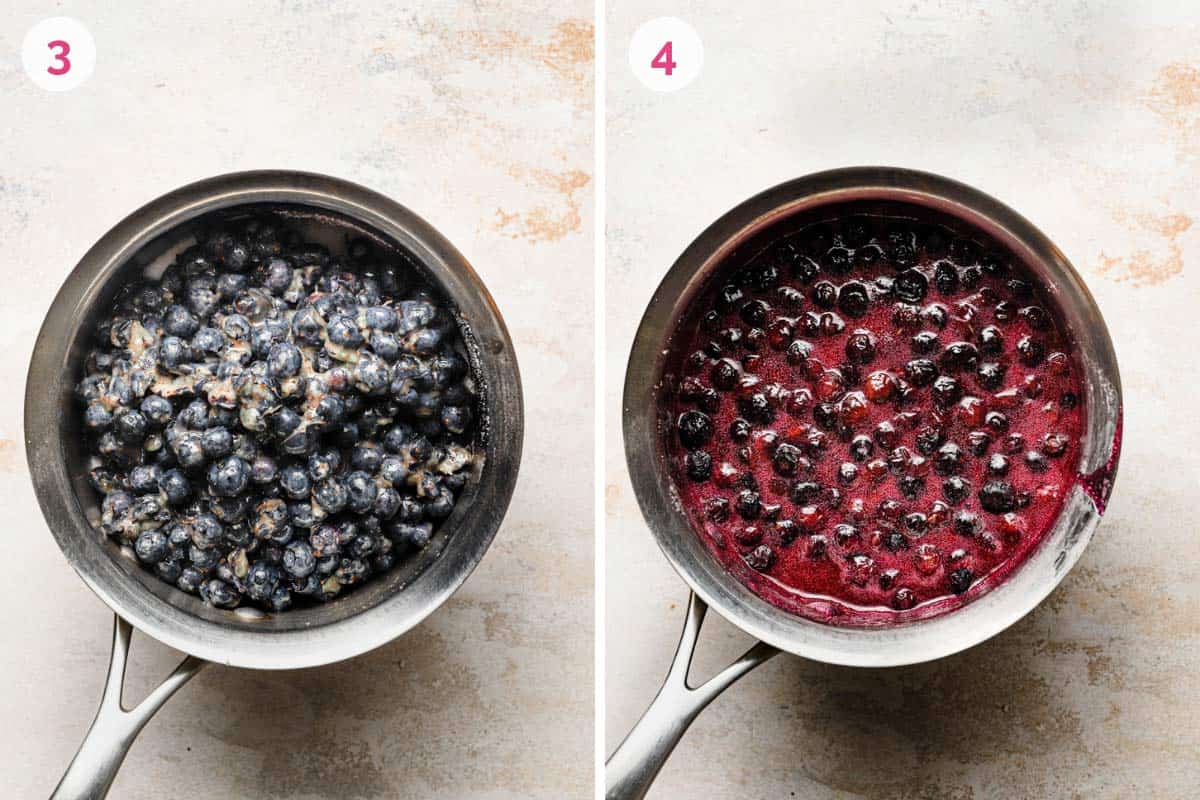
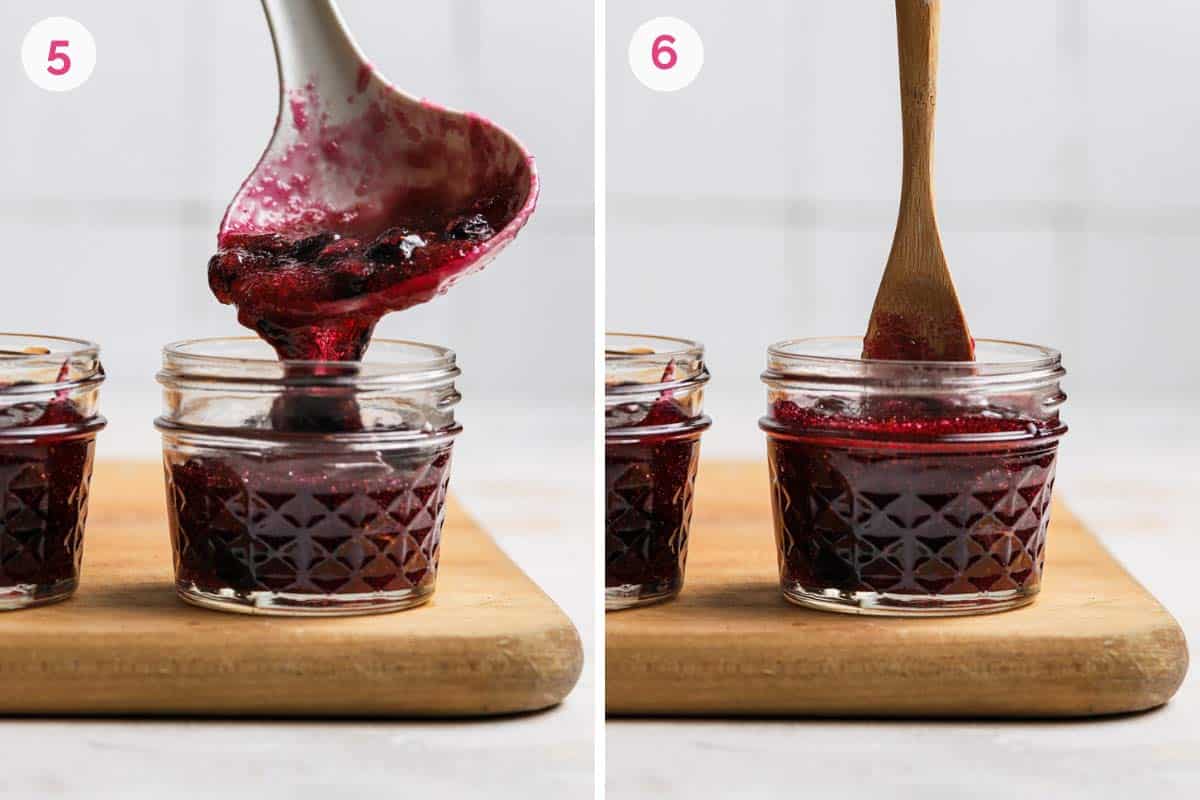
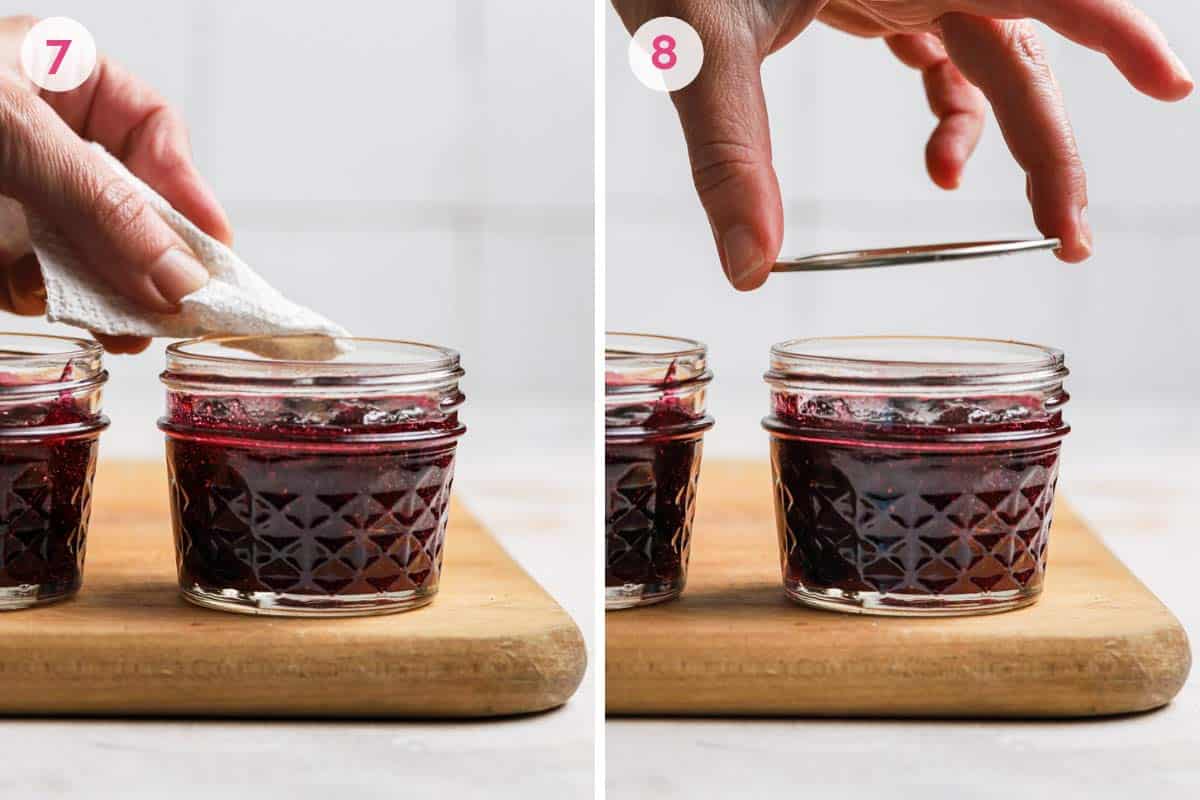
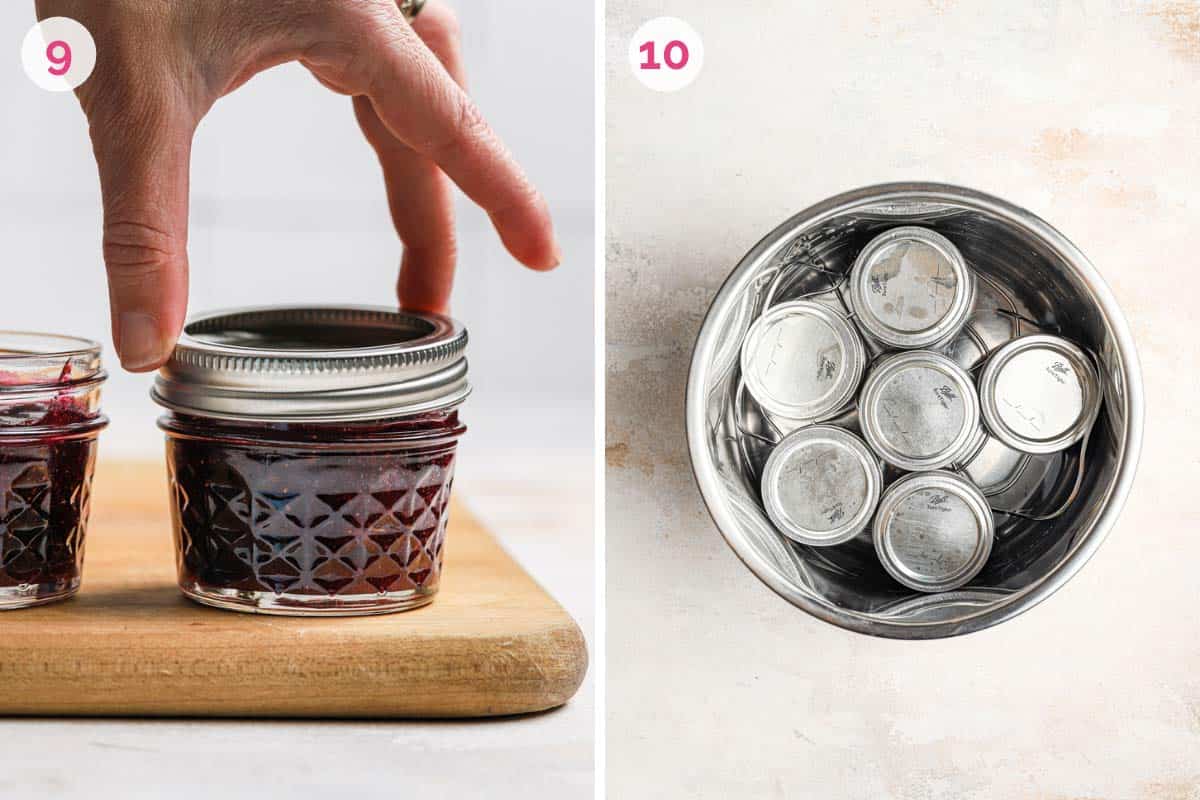
Recipe FAQs
The easiest way to thicken your jam is to allow the sugar and blueberry mixture to cook down by boiling. Then thicken and set into a gel by using pectin.
24 hours. Once the jars of blueberry jam have boiled, they should cool for 24 hours to seal and set fully.
The lemon juice lowers the pH of the blueberry jam mixture allowing the pectin to form a gel when added to the mixture. This is what gives it that thick jammy finish.
Yes! You will just need to process each batch in the water bath separately, one after another.
Yes! Just be sure to use refrigerated jam within 3 weeks or freeze for up to 6 months, then transfer to the refrigerator and use within 3 weeks of thawing.
Storing and Freezing Directions
After you have made your jam, you will want to make sure you properly store it for peak freshness.
- Sealed Jars: Store jars with a proper seal (see indicators in “Step 5: Check the Jars” to know if the jar has a proper seal) in a cool, dry place for up to 1 year.
- Opened Sealed Jars: After you have opened a sealed jar of jam, it will keep refrigerated for up to 3 months.
- Unsealed Jars: Keep jars that did not properly seal in the refrigerator and use them within 3 weeks.
- Freezing Directions: Place cooled and cleaned jars of blueberry jam in the freezer for up to 1 year. Thaw in the refrigerator before using.
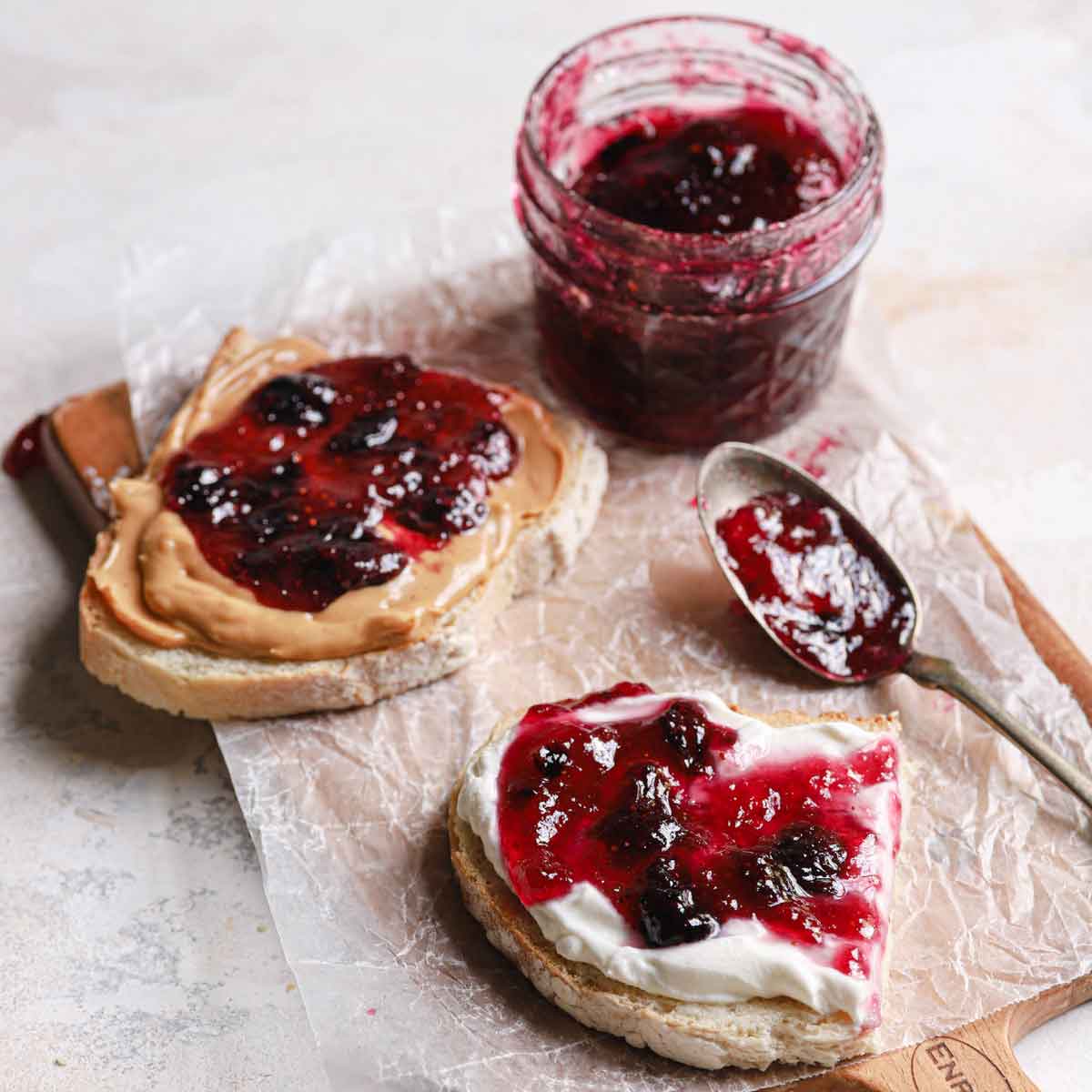
Ways to Use Blueberry Jam
- Slather on toast (made with my white bread recipe!), English muffins (or English muffin bread), or buttermilk biscuits.
- Use it to top buttermilk waffles, fluffy pancakes, French toast, and baked oatmeal.
- Stir it into vanilla ice cream or yogurt.
- Homemade jam makes a great gift! Package with a pretty ribbon and customized label (you can find some great ones on Etsy!) and share with family and friends for the holidays, a birthday, a teacher gift… any occasion!
More Blueberry Recipes to Make
Overcome your fears of canning and make this deliciously easy blueberry jam recipe! Made with fresh blueberries, lemon juice, sugar, and pectin, you’ll want to spread this on everything!
If you make this recipe and love it, remember to stop back and give it a 5-star rating – it helps others find the recipe! ❤️️
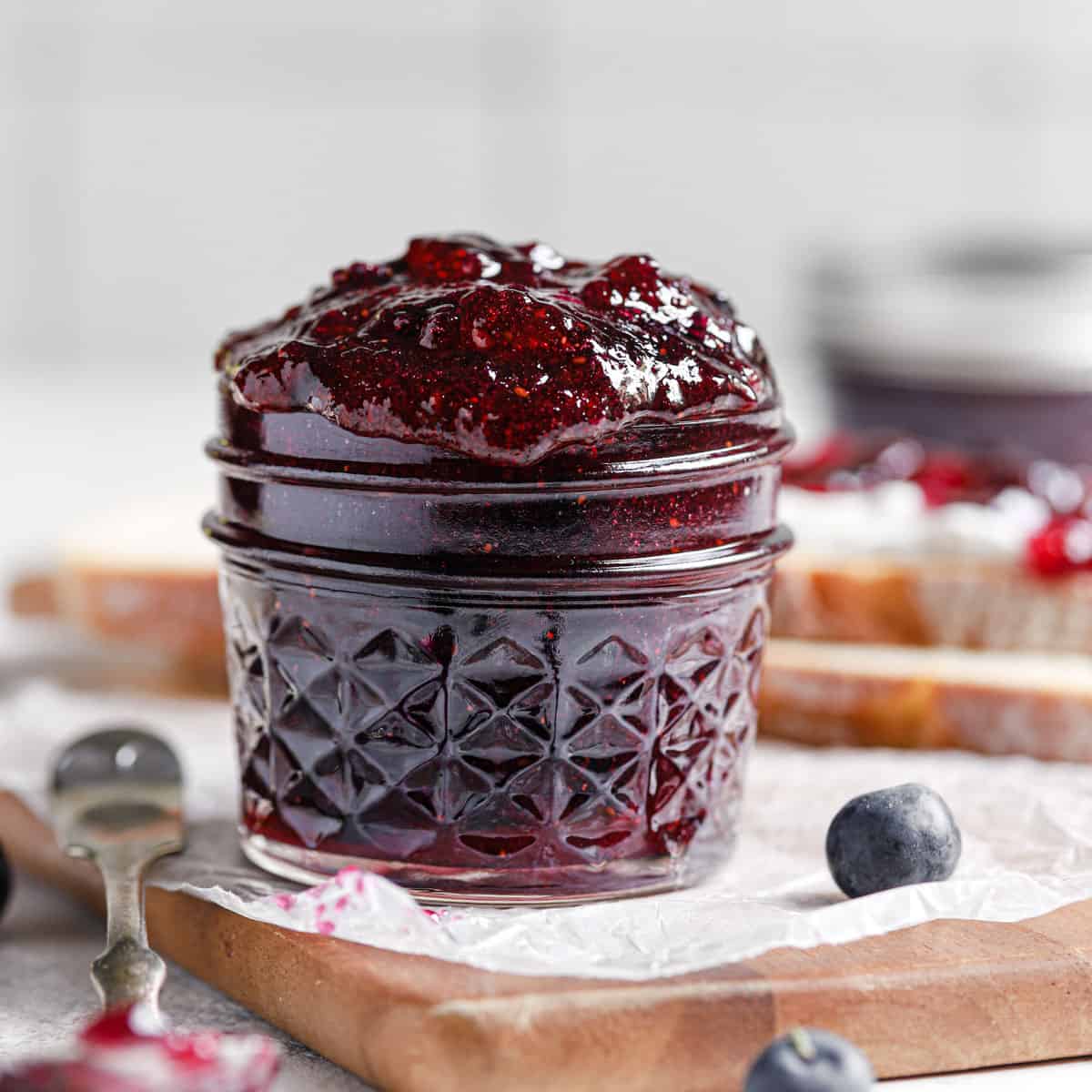
Blueberry Jam Recipe
Ingredients
- 4½ cups (698 g) crushed blueberries
- 4 tablespoons lemon juice
- 7 cups (1386 g) granulated sugar
- 6 ounces liquid pectin
Instructions
- Prepare canner, jars and lids. Wash the jars, lids and screw bands in hot, soapy water. Rinse well and drain (you don’t need to dry them). Place a rack in the bottom of a boiling-water canner, then place the required number of jars on the rack. Add water to the jars and the canner until it reaches the top of the jars. Cover the canner and bring the water to a simmer (180 degrees F) over medium heat. Do not boil the jars. Keep jars hot until you’re ready to use them. Place the lids in a small saucepan, cover with water and bring to a simmer (180 degrees F) over medium heat. Again, do not boil the lids. Keep lids hot until you’re ready to use them. Set the screw bands aside, they do not require heating.
- In a large, deep stainless steel saucepan, combine crushed blueberries, lemon juice and sugar. Over high heat, stirring constantly, bring to a full rolling boil that cannot be stirred down. Stir in the pectin. Boil hard, stirring constantly, for 1 minute. Remove from the heat and skim off any foam.
- Working with one jar at a time, remove a jar from the canner, pouring hot water back into the canner. Place the jar on a heat-protected work surface, such as a wooden cutting board or towel. Ladle the hot jam into hot jars, leaving ¼-inch headspace. Slide a nonmetallic utensil, such as a rubber spatula, down between the food and the inside of the jar two or three times to release air bubbles. Adjust headspace, if necessary, by adding more hot jam. With a clean damp cloth or paper towel, wipe jar rim and threads. Using a magnetic or nonmetallic utensil, lift a hot lid from the water and place it on the jar, centering the sealing compound on the rim of the jar. Place a screw band on the jar. With your fingers, screw band down until resistance is met, then increase to fingertip-tight. (Do not use excessive force to tighten.) Return the jar to the rack in the hot water-filled canner. Repeat filling steps until all jars are filled.
- When all of the jars are in the canner, adjust the water level in the canner so that it covers the jars by at least 1 inch. Cover the canner with a lid and bring the water to a full rolling boil over high heat. Once the water is boiling hard and continuously, process (continue boiling) for 10 minutes. Turn off the heat, remove the lid and let sit for 5 minutes. After 5 minutes, remove the jars, lifting them out of the hot water without tilting them. don’t dry the lids or jars at this point. You don’t want to disturb the lids while the seal is being formed. Place the jars upright on a towel in a draft-free place and let cool, undisturbed, for 24 hours.
- When the processed jars have cooled for 24 hours, check the lids for seal. Remove the screw bands and with your fingers, press down on the center of each lid. Sealed lids will be concave (they’ll curve downward) and will show no movement when pressed. Jars that have not sealed properly must be refrigerated immediately. Use unsealed refrigerated product within a few days. For the jars that have good seals, with a damp cloth, thoroughly wipe lids and jar surfaces to remove any water residue or food particles. Store the sealed jars of jam in a cool, dark place for up to 1 year.
Notes
- Equipment: Canning pot / Canning essentials set / 8-ounce jars
- Liquid Pectin: I found this in my local grocery store where they had a little display with jars, lids, and canning accessories. It can also be purchased online.
- Sugar Substitutes: You can substitute 3½ cups of honey for the sugar OR 2 tablespoons + 1 teaspoon Stevia.
- Storing Sealed Jars: Store jars with a proper seal (see indicators in “Step 5: Check the Jars” in the post above to know if the jar has a proper seal) in a cool dry place for up to 1 year.
- Opened Sealed Jars: After you have opened a sealed jar of jam it will keep refrigerated for up to 3 months.
- Unsealed Jars: Keep jars that did not properly seal in the refrigerator and use them within 3 weeks.
- Freezing Directions: Place cooled and cleaned sealed jars of blueberry jam in the freezer for up to 1 year. Thaw in the refrigerator before using.
- Canning Alternative: If you cannot procure the necessary equipment for long-term storage, you can still make this recipe. Use refrigerated jam within 3 weeks or freeze for up to 6 months, then transfer to the refrigerator and use within 3 weeks of thawing.
- Recipe adapted from Ball Complete Book of Home Preserving
Did you make this recipe?
Leave a review below, then snap a picture and tag @thebrowneyedbaker on Instagram so I can see it!
Photography by Dee Frances.


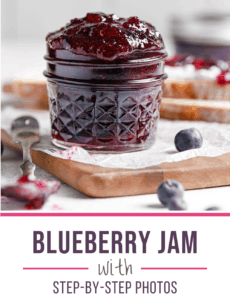



So sorry! I just found my answer in your notes! That’s what happens when you get old…
Can frozen blueberries be used for this jam? Thank you
AMAZING INSTRUCTIONAL POST!!!!!!
Thank you so much! I think you just took all the “skip this recipe” anxiety away from ever trying jam!
It looks so good, I like your description of the “slowing down” immersion and best of all….THAT PHOTO! Overflowing goodness!
I followed the recipe but the blueberry jam is on the runny side. How can i solve this problem after canning it?
Can you substitute powdered pectin or mix powdered with water to achieve liquid pectin
Hello again! Another question… the recipe calls for 4-1/2 C chopped blueberries… in Certo Pectin’s recipe, you start with 8 C of blueberries, then chop or crush them down to 4-1/2 C. The weight in grams stated in your recipe is 666g blueberries – is it possible that this reflects the whole berries, not the chopped? My 8C blueberries weighed just over 1100g, and reduced to 5C after crushing/chopping.
Thank you for this recipe! I have never tried canning before, but you make it sound so easy. I also featured this recipe on my blog, and I hope to try it soon.
Looks delicious! Will this recipe also work for huckleberries?
I have been making jams for years and don’t even use a recipe any more! I just made blueberry this past week! Here are my tips: 1) I use the low-sugar pectin in the pink box over liquid pectin — it is fool proof. 2) I always use 1:1 sugar:fruit. 4 cups of blueberries plus 7 cups of sugar sounds way too sweet! 3) I personally omit the lemon. 4) I don’t have a canning bath but I use my largest pot, put the jars in with lids, cover with water, and I do boil them concurrently as I’m making the jam. 5) I bought a canning kit for about $7 at a grocery store and it has rubber tongs to pull out the boiling jars and a magnet wand to pull out the lids. Also a funnel that helps with filling the jars. 6) I do a quick pulse with an immersion blender after adding the pectin because I like a smoother texture to my jam, although I do leave some whole fruit as well. It takes me an hour from start to finish for a small batch of jam including set up and clean up. I recommend placing old towels all around because jam DOES spill as it’s being filled, and it makes clean up so much easier.
7 cups of sugar???
I did a double take on the sugar amount. At first I thought it might have been a typo. Is that common to have more sugar than fruit in jams? I even thought 1 cup of sugar would have been a large amount. Has anyone tried using a lot less sugar and still enjoyed it? Maybe this is what jams really are, is all sugar. Well it still looks beautiful.
Thank you for this recipe. We have two blueberry bushes in our yard. They are loaded with blueberries this year. They should be ready to pick soon. I always freeze some for muffins, pancakes and breads. This year I will be trying this recipe for blueberry jam.
I followed the recipe exactly as stated and it was so sweet that we couldn’t eat it. I had to make another batch without sugar and mix the two batches for it to be edible for my family. Next time I will only use half the amount of sugar for our tastes.
Delicious :)
I just made this recipe with the blueberries I picked and this is my first time making blueberry jam. The only issue I have is the sweetness.
I love this simple jam recipe! I decreased the sugar slightly since I only had 4 cups of blueberries. Tastes amazing!
Can I use different fruits with this recipe? I’d not do you happen to have one for strawberry jam. My 5 yr old twins won’t eat anything else.
Yes, you definitely could! Enjoy!
Can you use honey instead of sugar. I’m trying to use less bad sugar an more healthy alternative.
Hi Keno, I am not an expert at canning, and I’m not sure if switching from sugar to honey would affect the pH at all, which could affect the ability to store long term.
I have never tried Cannine but I was told before you could just fill the jar and put it in the freezer. Is this not true. I’m also making your paczki recipe, is this the type of jam or jelly that you would put inside the paczki? If not what kind of jelly would I put inside the Paczki
Hi Carrie, You could put it in the freezer, you just can’t store it at room temperature without proper canning technique. Yes, you could put this inside the paczki if you’d like!
I’m going to be making huckleberry jam soon. If you think blueberry jam is awesome (and it is) then huckleberry jam will take your taste buds over the moon! I recently read that pectin (these days) is pretty bad for you, GMO corn bad for you, which is what Surejell is made from. And the pectin made from citrus is also loaded with chemical pesticides and juice strippers, of course right? So I’m going to try to make my jam by getting it to 220°F (gel temp. on a candy thermometer) at sea level, as fast as I can. Then I’ll add some lemon juice to brighten the flavor of the cooked jam. I will also try to use a ratio of 2 cups of sugar to 3 cups of fruit. I’m kinda nervous, I’ve never not used pectin before, or such a low amount of sugar.
I love to can for the very reason you stated…. slowing down. I call it my cooking Prozac. I love to do blueberry and hot pepper jellies/jams. Such sweet heartfelt Christmas gifts or anytime hostell gifts. Always well received. Your jam looks wonderful!
I just canned for the first time today. 22 half pints of hot pepper hot dog relish. I wanted to make blueberry jam and your recipe looks wonderful. This may be a dumb question but how do you crush your berries I want jam not preserves and do you use fresh lemon juice of do I have to use the bottled stuff?
Hi Terry, I used a potato masher and fresh lemon juice.
Love your story and recipe. Last year was my first year to can jams. Started with strawberry then I picked wild raspberries. The Rasberry jam is great. Then made peach jam. This year I’m traveling to eastern Ohio to pick blueberries from a old orchard and adding this to my selection. Best part is giving it away to people as not many people make jam anymore.
How many “Pints” of blueberries will it take to make the 4 /12 cups of crushed BB needed for this recipe?
Linda, I used 3-4 pints of blueberries to get the 4.5 cups crushed.
Hey Michelle
Thanks for your reply, I don’t have the Ball Complete Guide to Home Preserving. I have the Ball Blue Book and it DOES NOT have a recipe for just Blueberry Jam, it has one for Blueberry-Lime Jam.
Guess I need to get the Ball Complete Guide to Home Preserving.
Thanks for the information. I am looking forward to doing your recipe whenever the blueberries come to harvest this year
I am a newbie and I have read the Liquid pectin “should not be brought back up to a boil” once it has been added to the mix. I noticed you did bring the mix back up to a full boil for one minute after adding it to your mix.
Can you help me out and explain that please. I know everyone does things differently and its very confusing to a newbie.
Love your instruction and I may try this one whenever the blueberries come into season.
Thanks
Hi Linda, As I mentioned in this post, I’m a total newbie to canning as well, which is why I used the Ball Complete Guide to Home Preserving to guide me. I followed their recipe to a T, which is what is described above. After asking around and talking to folks that can quite a bit, everyone recommended the Ball book to me as a good starting point, and said it’s basically the canning bible. So I just went with what their recipe stated and had great results!
Hey Michelle! I have a question, I have been looking at several jam recipes because I want to give them out as Christmas presents, but I am not sure if you absolutely have to use fruits that are in season, can I make strawberry jam even though strawberries are not in season during December or would that really affect the outcome of the jam? Thank you (:
Hi Nataly, You certainly can, if you can find decent strawberries. That’s the hardest part about fruit not being in season – most times it’s hard to find good batches of it. If you access to it though, go right ahead!
i MADE A DARK cherry jam from Canadian cherries. I just saw a bunch of them at a good price and bought them. I had just ordered a jam machine. Can only can 4 or 5 jars at a time (closer to 4 jars as don’t want it to boil over. But was really easy to make the jam and then had to can it in a regular soup pot with a silicone “cage” for the jars. Was so easy I wondered why I hadn’t made something before. I have strawberries now to do tomorrow. I also have a couple red sweet peppers and a few Scotch Bonnet hot red peppers for a hot jelly. Anyone know a recipe for something like that? I use way less sugar than your recipe but then I get a dry pectin made for lower sugar recipes. Someone who made the hot jelly suggest apple juice to add for the added pectin and liquid. Yours is probably really good with the sugar but I’ve used unsweetened jelly or jam before and try to cut the sugar as I am diabetic. I know of no way to do sugar free or to add Splenda. I’d love to have a recipe that worked doing that. Thanks for your recipes. I just found this site today but have already added it to my favorites and subscribed. I appreciate the work.
Okay so I forwarded this recipe to my mom who is blueberry fanatic. She is recently retired and has lots of time on her hands. She had a couple of questions. First does it have to liquid pectin or can she use the powder and second she is diabetic and would like to use splenda instead of sugar is this possible?
I love your blog and I’m always talking about it while I teach cake decorating for Michaels. I love that you do everything homemade just wish I had more time to do the things you entice me with ;)
Robyn
Hi Robyn, This recipe is specifically developed for using liquid pectin, which reduces the boiling time. There are other recipes that use powdered pectin, but the instructions do vary. If she needs to use powdered pectin, I would search out a jam recipe that calls for it, since the cooking time will be different.
As for the Splenda, I checked out some agricultural departments, and found that Splenda is not recommended for jam or jelly recipes that call for the use of pectin (either liquid or powdered). If you are interested in learning more about where Splenda can be substituted, you can check out the FAQ here: http://nchfp.uga.edu/questions/FAQ_general.html
Thank you so much for the kind words and for sharing the blog with your class! I loved taking classes at Michael’s :)
Your jam looks great! I have been wanting to try canning but it just seemed so much trouble with having to prepare so much fruit and the jars. Blueberry seems like a great place to start. I’m going to try it this weekend! Just one question–how many pints of blueberries did that add up to (so I know how much to buy)? Thanks:)
Hi Kimberly, I bought 4 pints of blueberries and had some leftover once I had 4.5 cups of crushed, so you should be good with that amount. Have fun!
I LOVE to can! In fact, I’m actually making 70-80 jars of jam for my sister in-law’s bridal shower favors. (I’m crazy, I know!) Last year I canned a whole bushel of tomatoes, and it is SO wonderful to reach into your pantry in the middle of a blizzard and pull out a can of tomato sauce from your garden. I’m just up north of you in Erie, so I can feel you pain on long cold winters with no fresh produce!
Wow, that sounds awesome! What a great idea for favors! I think tomatoes are next on my list. We’ve had so many from the garden this summer, but things might slow down before I have a chance to get to them. Next year, for sure!
I’m so proud, hehe! Your jam looks absolutely amazing, and I’m so glad you’ve been bitten by the canning bug. And I can’t wait to see all the gorgeous jams & jellies I know you’ll be creating now that you’ve conquered your inaugural batch!!
Glad to hear you took the plunge!
Making jams (and jellies, marmalades, relishes) is so much easier than people think. And if you don’t want to do the whole canning thing, you can make small batches and refrigerate or freeze them (works great with stawberries). Once you master a recipe, you can then play: add a tablespoon or two of booze (cassis in raspberry), mix flavours (blueberry with a jot of lime).
I live in the UK now and there is jamming sugar here, which is sugar with powdered pectin added. I think this is great stuff: like a soft set (like me), then use half jamming sugar and half regular; need a firmer set, just increase to 100%. So simple!
My current fans: raspberry and rhubarb (inspired by Lottie+Doof’s crostata, pear, pineapple & lemon (inspired by Dorrie Greenspans’s Jammers), and Hedgerow ( a mix or blackberry & damson) jelly.
If you love the jam, you really need to try Blueberry butter….no harder to do, but way more delicious!
Oh my, blueberry butter?! That sounds insanely good!
Your jam looks beautiful. I made strawberry jam for the first time last year and was suprised how easy it was. I didn’t use pectin or a canner I think I still have a lot to learn. But I know what I will be doing with the fruit from the garden when we can’t eat it all.
I have ONE go-to recipe that I use for ALL my jams. You can use any combination of fruit and since its a low sugar recipe, you can really taste the fruit without it being overly sweet:
10 cups mashed fruit
1/4 cup lemon juice
1 & 1/2 packages low to no sugar pectin (powder)
~ 3-4 cups sugar (I go by taste, I dont like my jam overly sweet)
In a large saucepan, combine fruit with lemon juice. Mix the pectin with about 1/4 cup sugar to keep from clumping and add to fruit. Heat over medium heat. Bring fruit to hard boil for approximately 1 minute. Add sugar. Bring to hard boil again, stirring frequently, for approximately one minute. Check consistency with cold spoon. If too runny add a bit more pectin (make sure you let jam cool, jam will be runny if hot). If not sweet enough, add more sugar. Pour into clean, sanatized jars and process for 5-7 minutes!
Over the years I have used this recipe to make several types of jam, including, huckleberry-plum, apricot-pineapple (makes a great glaze for a ham), huckleberry appricot, cherry-rhubarb, strawberry-rhubarb, strawberry, huckleberry, huckleberry-rhubarb….the possibilites are endless! I hope you enjoy this recipe as much as I do!
Hi Morganne, Thanks so much for sharing your recipe! I can’t wait to give it a try!
What a great post. Jam is something I’ve wanted to try but have been hesitant because it is so much work, but I love your description of the accomplishment felt and comparing it to making yeast bread. Reading this post makes me want to go into the kitchen and tackle making homemade jam right away.
Can’t wait to try this one, delish!
I just started canning this summer and am completely addicted! It is strangely therapeutic. I started out with jam, then made pickles – LOTS OF PICKLES, but I am now feeling the urge to make jam again. I’m thinking that might be on the agenda for the weekend.
Sometimes getting fully immersed in cooking is the best relief for the everyday stresses of life!
Is jamming supposed to be intimidating? We used to make them in middle school in a class call FACS (family and consumer studies, the successor of the olden day’s home ec) and it always seemed simple.
Since then, I haven’t made a jam in over a decade. But I’ve been meaning to pick it back up since we have a horrible blackberry invasion happening and I figure I might as well harvest all the fruit before I kill the damn weeds. It seems like a good outcome — jam and death.
Canning makes me feel like my grandmother is in the kitchen with me! She always had shelves of mason jars filled with green beans, pickles & tomatoes. My favorite item to can is “Chow Chow” which is a relish to be used on everything from pork to black eyed peas. I’ve done a few jellies & salsas but my family’s favorite is hands down, the Chow Chow. Congrats on the success of your canning efforts!
Thank you, Debbie! I’d love to try a zucchini relish in a few weeks if we keep getting tons of zucchini in the garden!
I have an old tried and true zucchini relish recipe that goes back a few generations. I use it every August to make a few batches. We love it in tuna and egg salad and as a side with certain meats. Happy to share. Reach out when you’re ready.
Carol
I would love to can someday too. I have wonderful memories of my grandma canning when I was young and I definitely want to recreate that. My main question is – why so much sugar? Is it so it “sets” properly? I just imagine a bowl full of blueberries and that much sugar and it seems like way too much.
Thanks!
If you use commercial pectin(Sure Jell or Certo) their recipes call for lots of sugar. The process takes less time. You can also buy pectin for no sugar or low sugar. I prefer to cook my berries with half the sugar the recipe calls for til the mixture is 8 degrees above boiling. Takes longer but the natural pectin that is present will thicken the mixture. Takes patience, lots of patience.
Thanks!
I canned for the first time last year, including making jelly from the grapes off the vine in my back yard. Once that first jar lid popped, I was hooked and had a ball. My mom & I did apples (fabulous apple butter), tomatoes (heartburn-less tomato sauce), peaches and pears.
Looking forward to doing more this fall. This recipe is going with my canning “bible” for future use…
Went out and bought a canner and made some this morning! It’s already all set and they’ve all sealed firmly. Do I really have to wait 18 more hours? Ha, this is torture! So happy that my first attempt at canning was a success, and like you, I feel so accomplished!
Hi Jessica, I know, it’s torture, isn’t it?! The book says that it needs those 24 hours to seal and set properly, so I didn’t question it ;-) Someone did mention on Facebook, though, that you can just leave one filled can aside and not process it, then you can pop it in the fridge and eat it immediately. You just need to finish it within a week or so. I will definitely do that next time!
I’m not gonna lie…this is beautiful looking! Maybe I’ll be brave like you and start canning someday :)
This looks amazing. I will admit the idea of canning frightens me. I feel like it would be a ton of work and probably not work out in the end. However, I’m feeling inspired by your job well done. I don’t have a canning boiler. Can I use a deep pot instead?
You will need to put some sort of screen in the bottom of the “canner” to keep the jars off the bottom. We cut 1/4″ or 1/2″ rat wire to fit the pots we use. Need to keep the jars off the bottom to avoid breakage.
Ditto Leia! You can use a deep pot you already have, but you need to have some sort of rack on the bottom for the jars to sit on.
I’ve heard of using thick towels to keep the jars from moving around.
I’m so glad you tackled this and conquered it so that I can use your tips when I decide to try my hand at canning some day! :)
blueberry jam is the bee’s knees! your version looks store-bought quality… or better!
xo
http://allykayler.blogspot.ca/
i love blueberries and cant wait to try this!! this would make a great tutorial on http://www.amazine.com!!!
you should check it out! :D
ali x
Thanks for the inspiration I needed to get back into the kitchen. That blueberry jam looks amazing! I started canning jam last fall when, like you, after reading all of the labels, I just couldn’t bring myself to continue buying and eating all of that corn syrup. I started with a crock-pot salted caramel apple pear butter recipe I found on Pinterest and was hooked!
This so awesome! I’ve felt the same way about canning too. For some reason, it absolutely terrifies me. But I’ve always had dreams of canning fresh jams and giving them as gifts around the holidays. I may really give it a try now!
Your jam looks great, and it’s awesome you felt so good about making it. Peanut butter and jelly on crackers has always been one of my favorite things to eat too! It’ll probably take me awhile longer to get over my fears and misconceptions about canning, but this post brought me one step closer.
I can’t wait to try your blueberry jam – blueberries are one of my favorite fruits! my first jam experience, which was extremely successful, was the strawberry vanilla jam from another of my favorite food blogs. I had a quart of strawberries from the farmer’s market that were very ripe, and I knew I wouldn’t have time to eat them before they went bad, so I whipped up this beauty:
http://www.loveandoliveoil.com/2012/05/strawberry-vanilla-and-strawberry-balsamic-jam.html
it was SO easy, and turned out PERFECT. I’ve still got a jar in the pantry, just waiting to be busted open :) I highly recommend it!
I had those same fears about canning, but I dived in a couple of years ago with great success. Last summer I discovered two recipes that are keepers: a Roasted Pepper and Tomato sauce; a Roasted Tomato and Chile Salsa. Just last week I canned 10 quarts of the tomato sauce and 13 pints of the salsa…and my garden is still producing tomatoes!!
Oh wow, those both sound amazing! Any chance you could share the roasted pepper and tomato sauce? I just picked 8 tomatoes from my garden yesterday morning; there are so many!
I have yet to begin canning anything myself. I’ve canned tomatoes and pickles before with my mom before, but never any jams/jellies/spreads. To me, you are the queen!
This jam looks thick and beautiful – perfect for buttery toast in the morning.
I have a fig tree in my backyard and I make a delicious fig jam! I use a lower sugar recipe to let the fruit taste shine and it is divine!
My tree yielded upwards of 15lbs of ripe figs a day, what a crop this year! I was giving the fruit away because I ran out of canning jars, but I did get 24 jars of jam put up! Next year I will be ready with more cases of jars!
Jam makes wonderful gifts over the holidays- you can make up a beautiful basket of home made english muffins, and jam! A taste of summer in the dead of winter!
Dehydrate your excess figs. I have some drying right now. Once they are done and cooled I will either put them in a jar and use the FoodSaver to pull out all the sir or vacuum seal them in FoodSaver packs and do some more tomorrow.
Oh my, I am so jealous of your figs! I’m lucky if I can find fresh figs in the Italian specialty grocery store for one week in the summer; they just don’t come into season here. I’m going to have to plant my own tree :)
Beautiful jam, Michelle!
Pickles! After jam they feel like a piece of cake! So far this year I’ve canned citrus (segments and marmalade), blueberry jam and bbq sauce, cherry pie filling, in syrup and jam and there are currently blackberries in the fridge waiting to go into jars! Next up peaches and tomatoes!
Oooh, that all sounds great! Unfortunately, my zucchini plants completely took over and grew over my pickling cucumbers this year. I love the idea of canning pie filling; I am going to have to try that!
Hi! You don’t need cukes to make pickles!! As a matter of fact, I have a recipe for sweet zucchini relish that is out of this world and would be delighted to share if you would like to have it! It completly takes care of the issue of overgrown, huge zucchini (that one that you missed and it grew to a MASSIVE size) and also eliminates the problem of the neighbors running away when they see you heading in their direction!!! Just let me know,
Holly
Oooh, I would love that recipe! I just pulled one of those zucchini the other day. Crazy how they hide!
This is the perfect use for overgrown or a glut of squash!!
Zucchini Relish
2 days about 6 pts.
10 c. chopped zucchini (about 5 #) 4 c. onions 5 T salt
Day 1:
Fine chop squash and onion in food processor. Add salt and let sit overnight on counter, covered with clean kitchen towel.
Day 2:
Line colander with cheese cloth or clean kitchen towel. Put squash/onion mixture into colander. Drain and rinse with cold water. Squeeze out as much moisture as possible, and put veg into a large pot.
Add:
1 finely chopped red and green bell pepper (food processor)
2 1/4 c. Cider Vinegar 4 1/2 c. sugar
1 T. corn starch 1 t. nutmeg
2 t. celery seeds 1/2 t. ground black pepper
Mix with wood spoon and simmer gently 30 mins. Fill hot sterilized jars, wipe rims, seal and process in boiling water bath for 10 mins.
Thank you so much for sharing this recipe!
Nothing beats homemade jam! Love the blueberry, but I must admit strawberry is my favorite!!!
I remember making homemade blueberry jam with my mom at our camp in Maine. There is a spot across the lake that has the best wild blueberries you ever tasted. Your post brought back happy memories. Thanks.
Congratulations! I was so excited for you when I saw your post of FB. You should try the Bourbon Peach Jam that is circulating on Pinterest. It is AWESOME!
Thank you, Robin! Bourbon Peach Jam sounds AMAZING! Definitely going on my list!
I’m completely terrified of canning. mainly of botulism. But maybe I should be brave like you and give it a try :)
Megan I certainly hope you have tried canning since you posted this in response to the blueberry jam! But if not DEFINITELY try it! I grew up doing it and still love it even though I have had to curtail since I have health issues…..I still do a lot of tomato based products and apple butter (cooked in a crockpot prior to canning) is another awesome product!
Beautiful! We can lots of jams and preserves but we like to use the longer cook method, not adding commercial pectin. That way we can adjust the sugar level of our recipes. Takes a bit longer but they turn out nice. Now you need to try Fig Preserves!! And marmalade. I have not seen the Ball Complete Book of Home Preserving, but we have used a couple of the recipes for canning pie filling.
Kudos for a job well done!!
I make black raspberry jam but that blueberry might be a new favorite.
It’s making me want some cornmeal waffles to go with that jam! Mmmmm
Blueberry jam has to be my absolute favourite (although cloudberry comes up close, too). I love crèpes with mine – something thin, not too substantial or smothering, but still there as a foil.
Gorgeous jam and I love the story-telling in the opening of the post.
PB & J on crackers – that was dinner in college mannnnny nights :)
Saw your last post, the coffee/crumb cake, on FG earlier today. So pretty!
Thank you SO much for sharing this recipe! I have been nervous about canning but I love to cook so I’m sure it’s not so hard and I just need to try it! I’ve been on a blueberry crazy lately so I think it’s about time I start canning and this blueberry jam sounds amazing. Thank you!
This looked so good, I had to make it! It turned out amazing, as you predicted. I did chop the berries in a food processor so there were less big berries. Ball says not to, but it turned out just fine. Many thanks for such a wonderful recipe!